2019 has already seen the release of five sixth-scale Roman-period military figures by two companies, and there is at least one more in the works. Although they arrived months ago, it is only now that I've had time to begin some product reviews. I begin with the three Roman infantry figures by Kaustic Plastik.
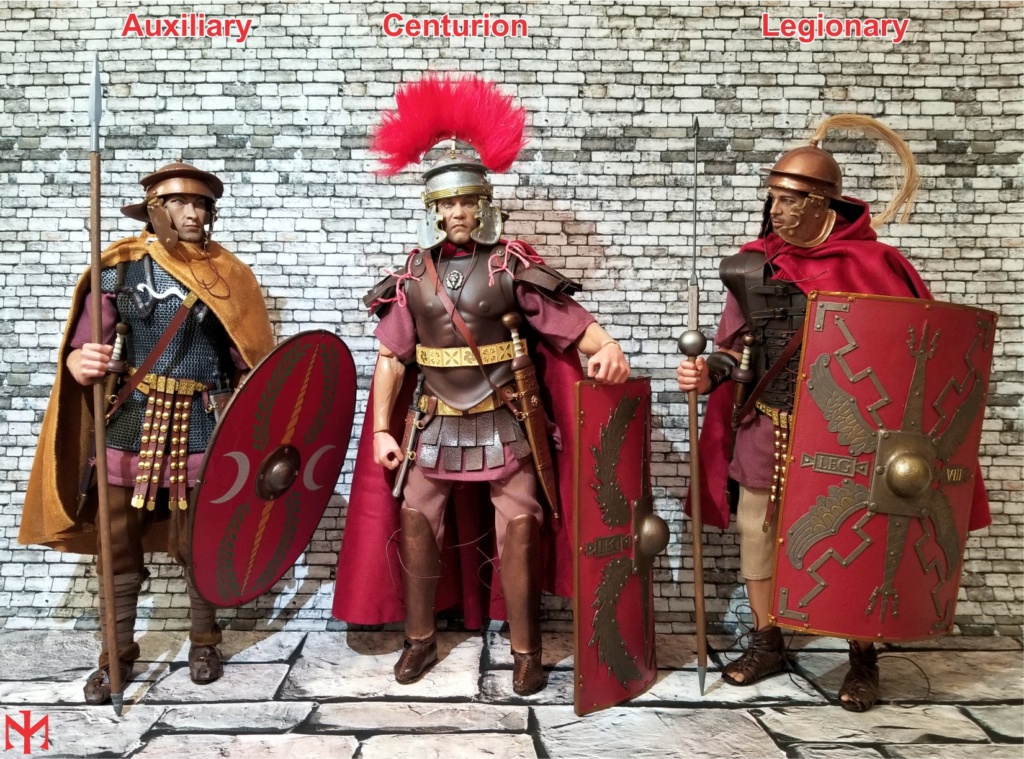
Introduction
The three infantry figures are a centurion, a legionary, and an auxiliary ("Auxilia Cohors") from Kaustic Plastik's The Legions of Rome - The Armies of the Roman Empire series. All three figures purport to portray the Roman military of the 1st century AD, i.e., the Julio-Claudian and Flavian periods of the Roman Empire. Kaustic Plastik figures are designed on the advice of archaeologists/military history consultants and claim a high degree of historical accuracy. That said, one should note that there is plenty of disagreement over the interpretation of pictorial, written, and archaeological evidence, and some of the design choices would be open to doubt.
The sets employ Kaustic Plastik bodies (KP04) and head sculpts and stand about 11.5 inches (29.5 cm) tall.
Packaging - 3/4 stars
All three figures come in identical boxes featuring a dark posterized version of a photo of two figures' helmeted heads overprinted with the Legions of Rome logo on the front, a general historical introduction on the back, and images of all four figures of this line (the three reviewed here, plus a cavalryman whom I will review separately) on the sides. Inside the box there is a relatively thin black foam sheet, under it a thick foam trey for the figure and some of its accessories, and under that a second, more shallow foam trey for additional accessories, including the action figure stand and the shields. The use of foam treys is commendable, and everything is reasonably safe, although some items do become loose. Inside there is also a little paper slip with a printed notice that the helmets are very delicate, should be handled carefully, and if any of the small fittings become loose it is recommended to affix them with Gorilla Superglue. So why take off one star? Because of the reusing the same box and decor for all figures in the line. This is arguably lazy, but while I do not care much about the boxes (as long as they do their job), the figures come without any instructions, and having more, larger, and varied images of each figure (on its respective box) would have been handy when trying to kit it out fully. On the other hand, if this cost-saving measure accounts for the relatively inexpensive price, that aspect is appreciated.
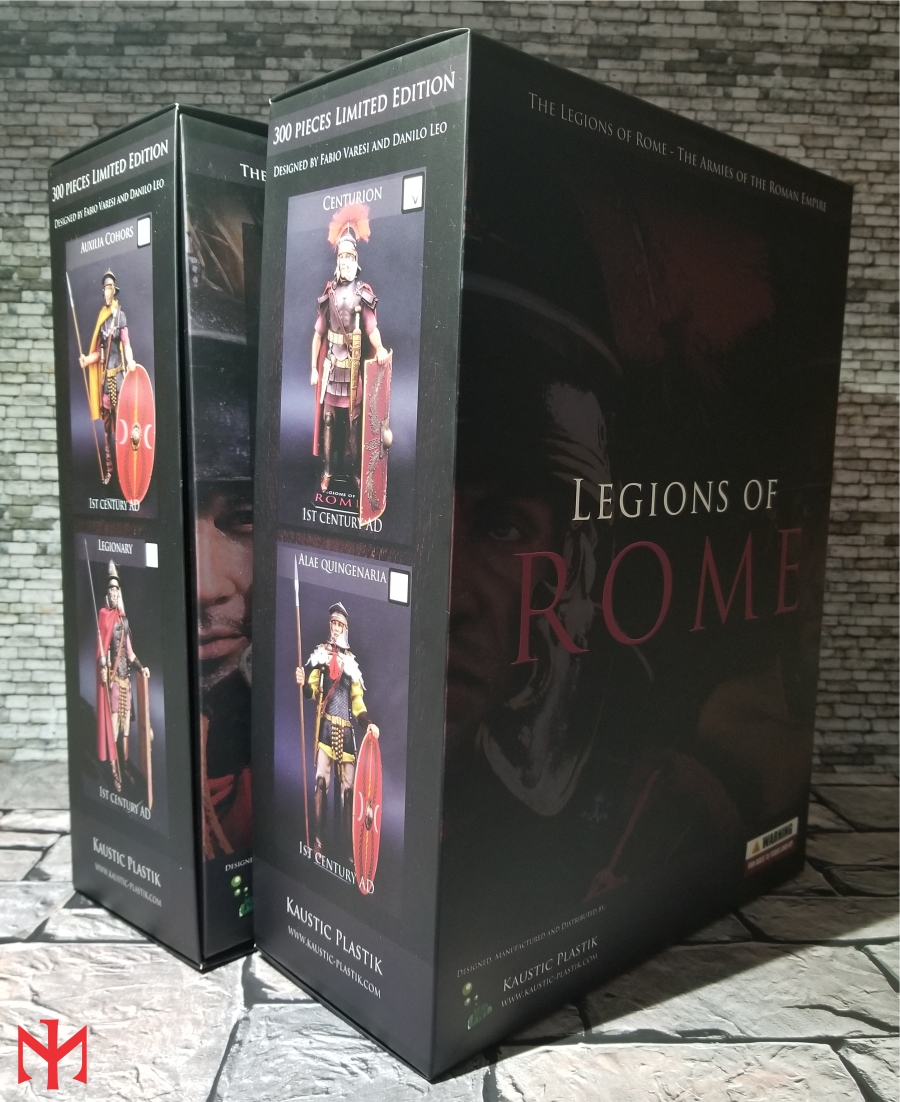
Sculpting - 3/4 stars
By sculpting I mean primarily the head sculpts, although there are plenty of sculpted details on the plastic and metal accessories that make up each figure's armor and weaponry. In the latter case, the detail is fairly accurate and quite exquisite, even if not always super sharp. In the former case, two out of the three heads are very well sculpted, while that of the auxiliary has the same high production quality, but suffers from fairly caricature-like features that detract from the intended realism. Moreover, all three head sculpts are reused from Kaustic Plastik products we have seen before: the centurion's head came with the KP03B body, the legionary's head came with the KP04B body, and the auxiliary's head came with "Valerius - Roman Legionary" ("Ancient Rome - The Roman Army - Legio XIV Gemina, Invasion of Britain circa 49 AD"). While I appreciate any savings in cost, this reuse is hardly something that impresses in the new products.
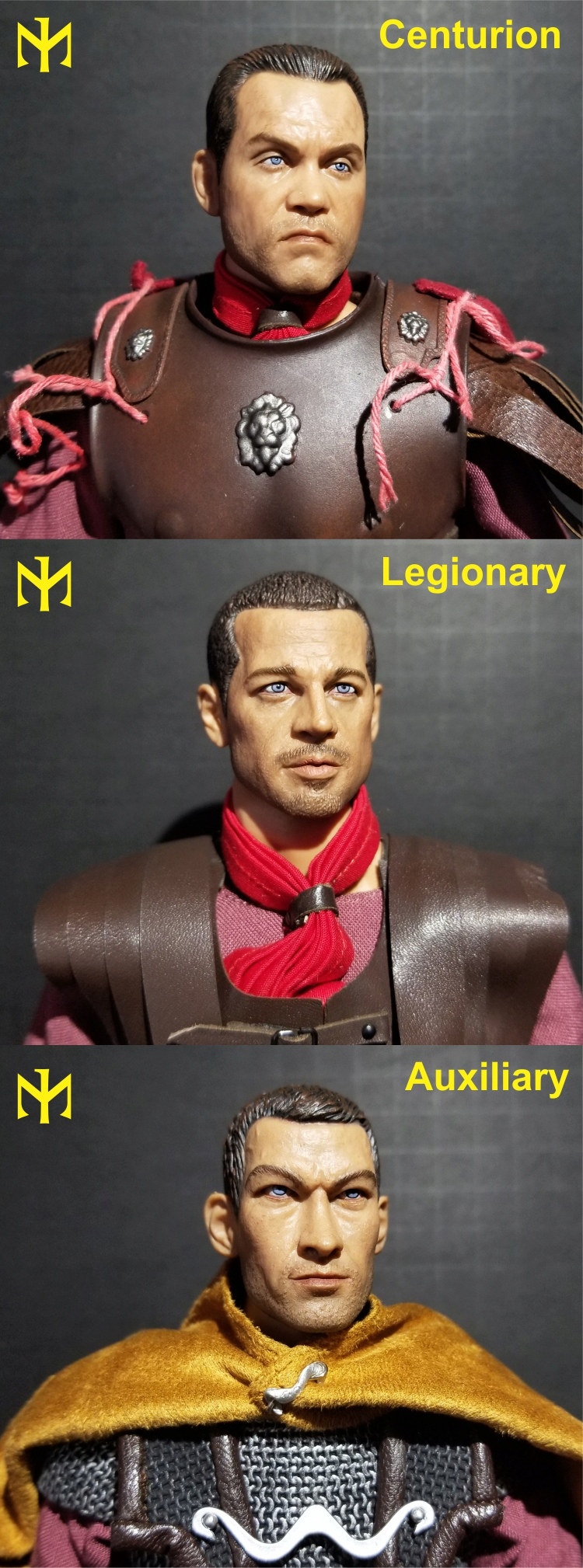
Paint - 3.5/4 stars
Generally speaking, the paint job is very good -- and even in instances where it is not particularly clean, that is perhaps on purpose, certainly contributing to the look of worn, used equipment. The most elaborate and detailed paintwork is on the head sculpts (see photo above), and that tends to be excellent, with plenty of good detail and nuance. There is also some fairly intricate paintwork involved with the various tiny sculpted details on the armor (centurion), sheaths (all figures), and shields. The "chain" mail on the auxiliary (and also on the cavalryman I would be reviewing separately) is made of molded rubber and has a very convincing paint treatment ranging from silverish to dark grey.
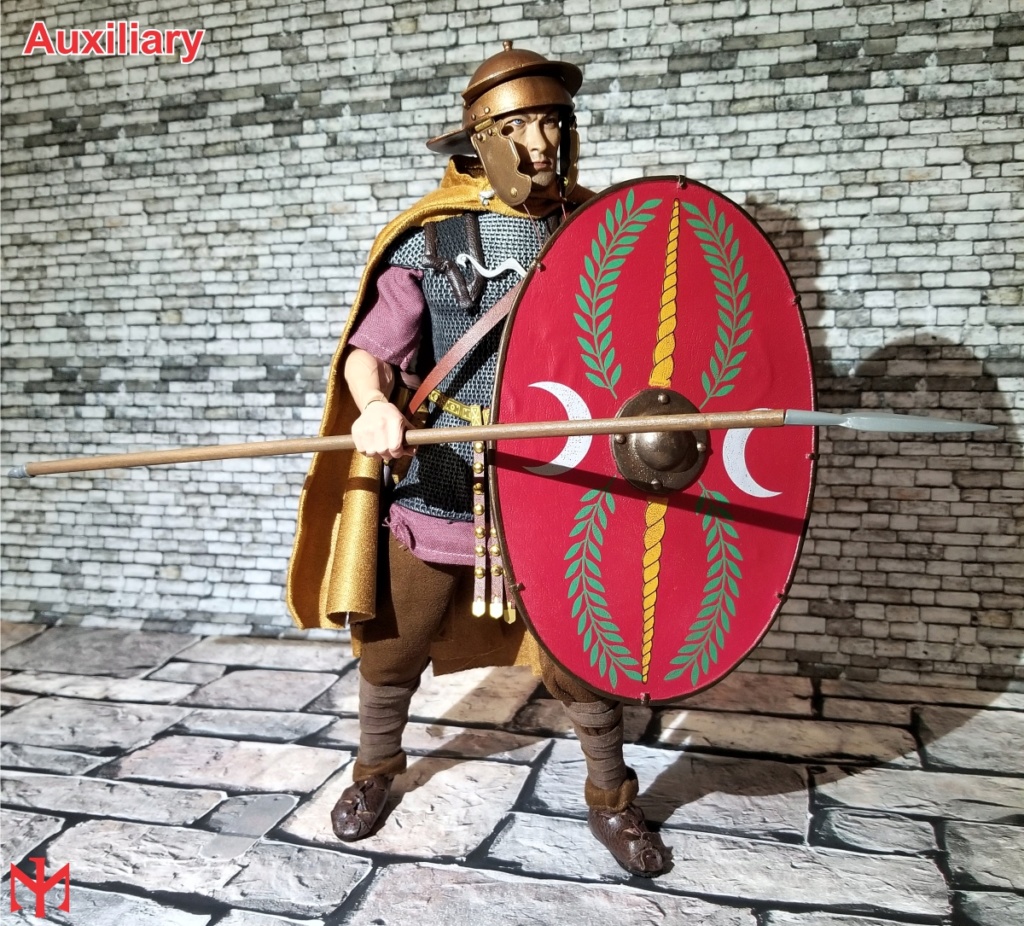
Articulation and Poseability - 2.5/4 stars
Why add "poseability" to the description of this category? Because it is different from the articulation, as I will show. In terms range of movement (articulation), the Kaustic Plastik bodies are very good, featuring almost everything you might want, including double-jointed knees and elbows, good ankles and wrists, ab crunch, etc. Naturally, the outfits and especially the armor (whether the molded rubber "chain" mail or the hard plastic "muscle" cuirass) get in the way a little bit, but that is normal. In fact, I am surprised at how little they hinder the range of movement (though I have not necessarily shown its full limits in the photos). A bonus for the kitbasher are the removable arms, which are pretty much a must if you want to remove or swap some of the outfit. However, when it comes to the ability to pose the figures, the products are plagued with difficulty. The knee and ankle joins in particular are fairly loose, and when you add to this the weight of plastic and metal weapons and armor, it becomes exceedingly difficult to achieve a balanced unassisted standing pose in any animated stance. For example, see the legionary in the photo below? He had to lean on his shield to stand in this stance, which wasn't even what I was going for in the first place. So while the articulation is good in itself, the poseability is fairly poor.
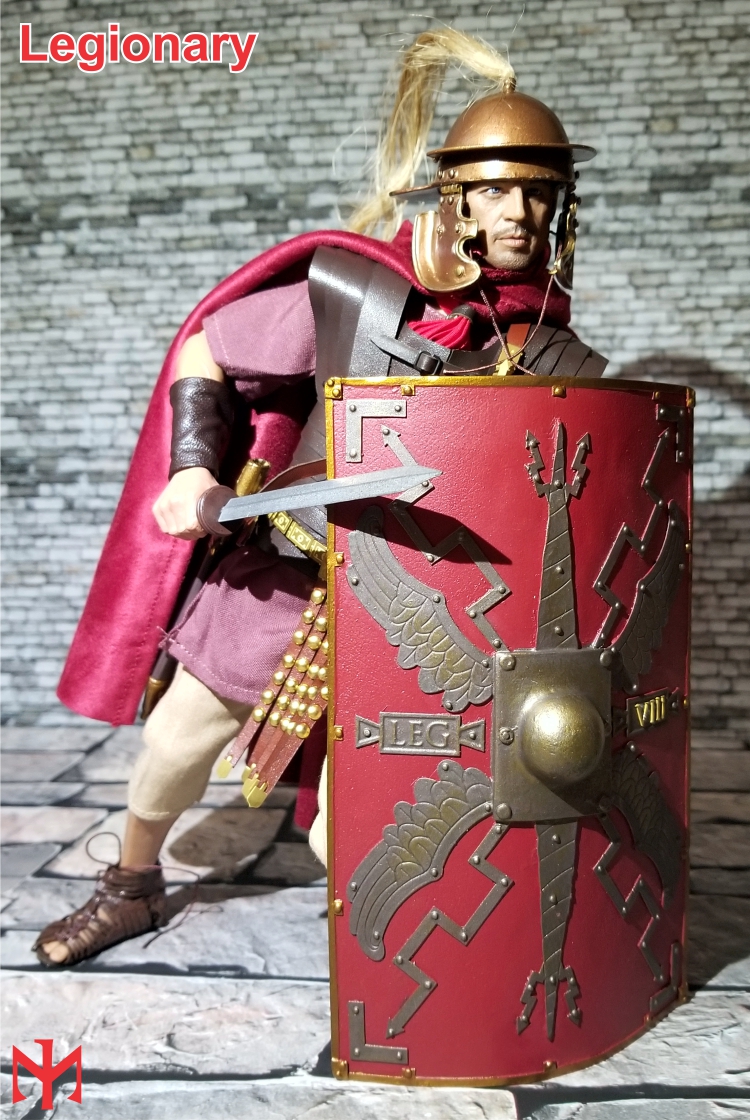
Accessories - 3/4 stars
Since we are looking at three figures at once, let's start with what they have in common: the "deluxe" figure stand, the dagger (pugio) with its sheath hanging from the military belt (cingulum militare), the sword (gladius) with its sheath hanging from a baldric, the two sets of hands (spear/sword/knife grip and trigger grip -- the latter is somewhat surprising given the nature of the product). The weapons' blades are made of metal, while the hands are made of fairly soft plastic -- something this reviewer appreciates, given the typical challenges of making a figure hold a shield or swapping weapons. Each figures comes with its own distinctive plastic shield -- the centurion and legionary have a similar and familiar design (scutum), but with slight variations, while the auxiliary sports an oval shield with painted decoration. At least generally speaking, this appears accurate for the period, although the universal reliance on red is a bit of a modernist cliche. The centurion sports an extra (and extra wide) belt to go over his armor. The belts are made of thin leather-like material with affixed and embossed metal plaques -- this works better in theory than in practice (see below). The auxiliary has a short spear or javelin (lancea) with attachable spearhead -- which also works better in theory than in practice (see the photo in the Paint category above). He has also been given two Gallic-type wrist torques. The legionary comes with a coiled rope and with three interchangeable shanks of varying lengths and weights for his javelin (pilum).

The legionary set comes with metal Roman numerals which you can use to affix a legion number of your choice to the appropriate "field" on the shield. You will need glue and possibly a coat of paint or dull finish (I have not yet applied the latter). This set also comes with additional pendants that could be attached to the ends of the danglers, but that seemed too fragile and too much trouble for me to affix.
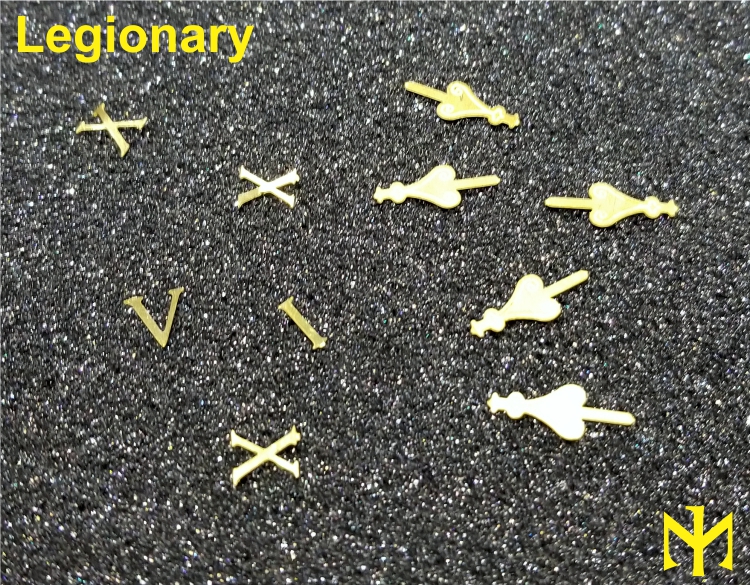
I am subtracting a star from this category because of the overly fragile or flimsy attachment of many of the elements, a source of much annoyance: see below.
Outfit - 3.5/4 stars
The centurion wears a red tunic, a leather-like jerkin (subarmalis) with two rows of pendant straps (pteryges) at both the bottom and the shoulders, and a muscled cuirass (whether it is intended to represent one made of leather or bronze is not specified -- although the color appears far too dark for ancient bronze). He also has red-brown pants (feminalia) reaching down to the upper calf and his lower legs can be protected by greaves (ocrae). On his feet he wears closed boots (calcei) with silverish hobnails. His lower neck is protected from the armor by a red military scarf (focale), and a heavy velvet-like red cloak hangs rather loosely from specially designated holes in the muscle cuirass. He has a metal Gallic Type E helmet with an attachable transverse crest. Apart from perpetuating the simplistic notion that the Romans employed red consistently or uniformly for such items as the military tunics, the choice of pants for a figure representing typical 1st century AD military personnel is somewhat surprising -- they are generally agreed to have come into common use late in that century, closer to the Year 100.
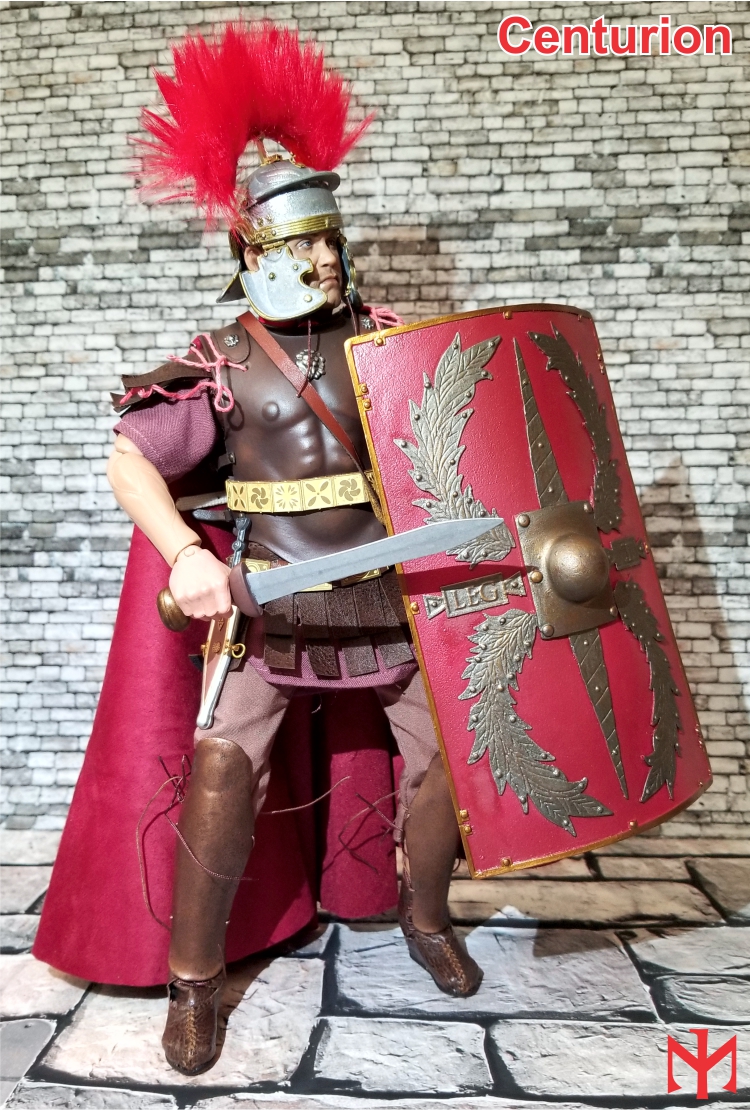
The legionary wears a red tunic, leather-like armor, knee-length light brown pants (feminalia), military boots (caligae) with silverish hobnails, leather-like wrist bands protecting the lower arms. His neck is protected by the red military scarf (focale) and he has a red hooded cloak to wear. His metal helmet is of the Coolus Type G, with a beige plume. The leather armor and wrist bands are of debatable historical accuracy. Generally, discrete wrist guards are not believed to have been part of typical legionary armament, and are common only among archers. The evidence for leather armor as anything more than an underarmor jerkin is particularly contentious. The promotional materials indicate that the leather armor that comes with this set is based on a drawing in Robert von Spalart book on historical costume (from 1798). Although not everything dated is necessarily wrong, that does not carry much weight with military historians today, and most interpretations based on pictorial or sculptural evidence are open to debate. Allegedly fragments of Roman leather armor have been found in Egypt, and Raffaele d'Amato's Roman Army Units in the Eastern Provinces 31 BC-AD 195 does include an illustration of banded leather armor worn by a city guard (not a legionary), citing pictorial evidence from an Egyptian linen shroud and from Anatolian monuments. Using "chain" mail would have been a considerably less controversial and more convincing choice; the use of pants is also possibly questionable, as they became more common late in the 1st century (as noted above).
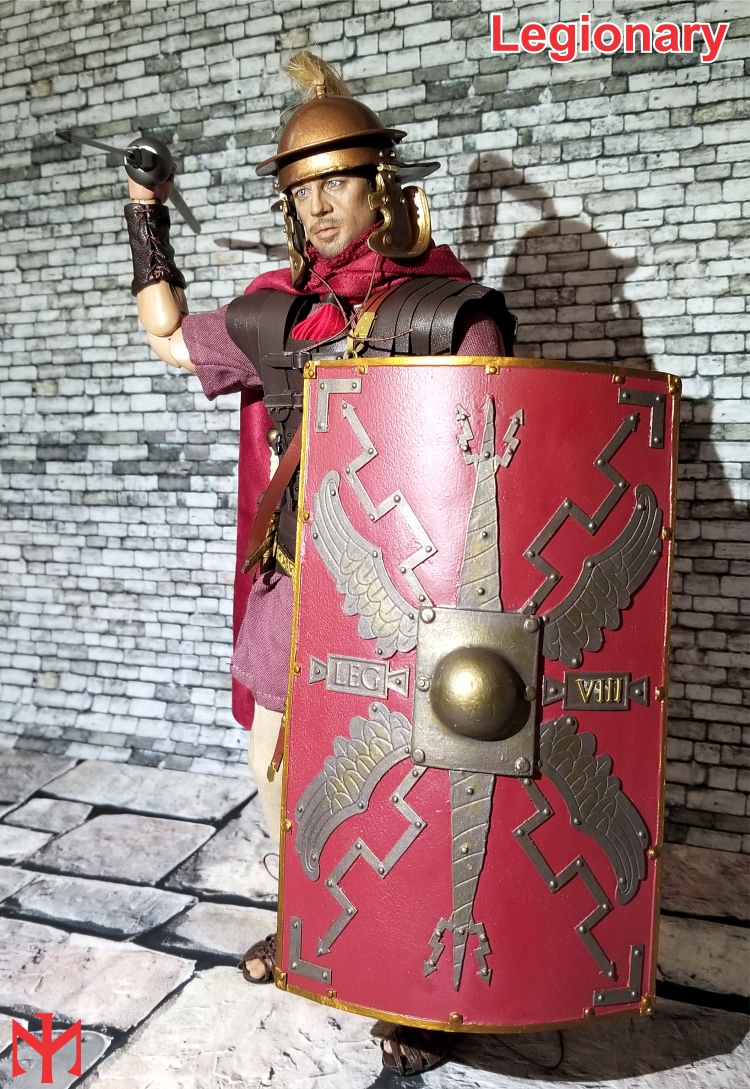
The auxiliary wears a red tunic, molded rubber "chain" mail with short sleeves and additional leather-lined "chain" mail shoulder guards (giving the armor the overall impression of a Greek linothorax), and . He had brown long pants (braccae), with his calves additionally protected by leg wrappings. He has been given Gallic closed sandals without hobnails, although it is likely that many or most infantry auxiliaries would have worn typical military boots (caligae). I suppose there is something to be said for variety. The pants (though more typically of the shorter type, feminalia) are less questionable here, as they appear to have come into common use among auxiliaries earlier than among legionaries, by the mid-1st century. This would have been especially true in the northern provinces along the upper Danube and the Rhine, and in Britain. The auxiliary sports a metal Coolus Type C helmet without a plume or crest.

Fun Factor - 3/4 stars
With four different contemporary figures produced at the same time, not to mention any of Kaustic Plastik's earlier Roman releases (gladiators and military alike), the fun factor for these products should skyrocket. Historically debatable choices aside, the attention to detail is commendable, as is the range of options we get at once and over time. What hurts these products in this category is the common issue of limited poseability (due to overly loose joints) and the flimsiness of a number of articles that break repeatedly with minimal handling (more on that below) -- which makes posing these figures a frustrating rather than fun experience. On the other hand, if you just want to stick them on the provided figure stands and forget about them on a shelf, that frustration largely disappears.
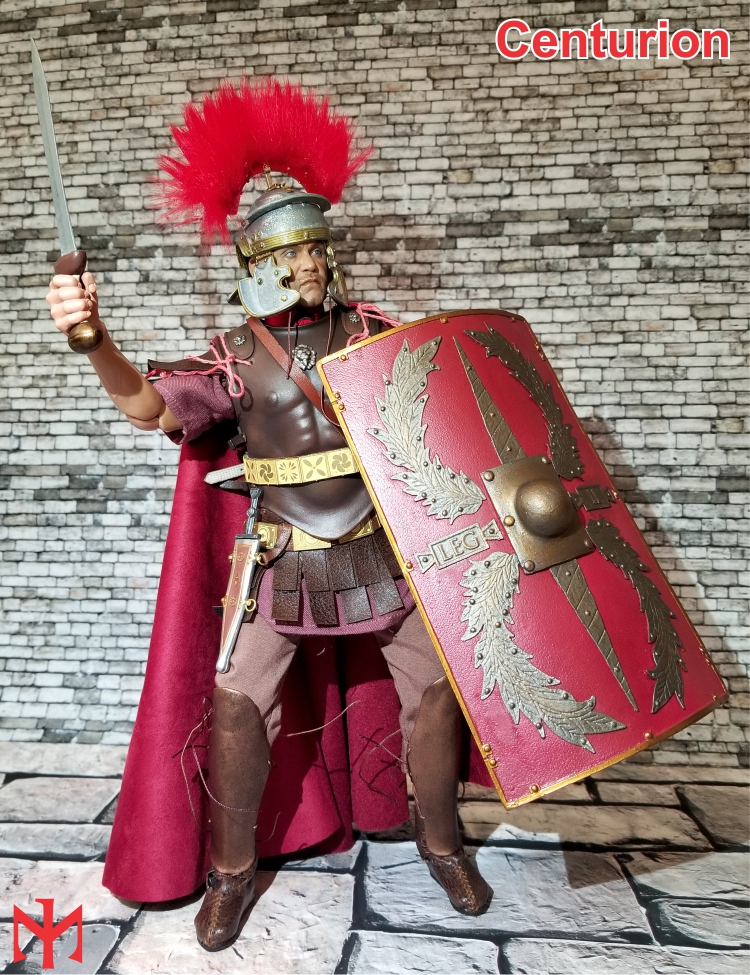
Value - 3/4 stars
Retailing at about $140-160 (USD), these are not particularly expensive for high-end action figures these days (something relative, of course). Given the research, care, and large number of fine accessories that come with these sets, I would have given this category a full 4 stars had it not been for the frustrating issues mentioned above.
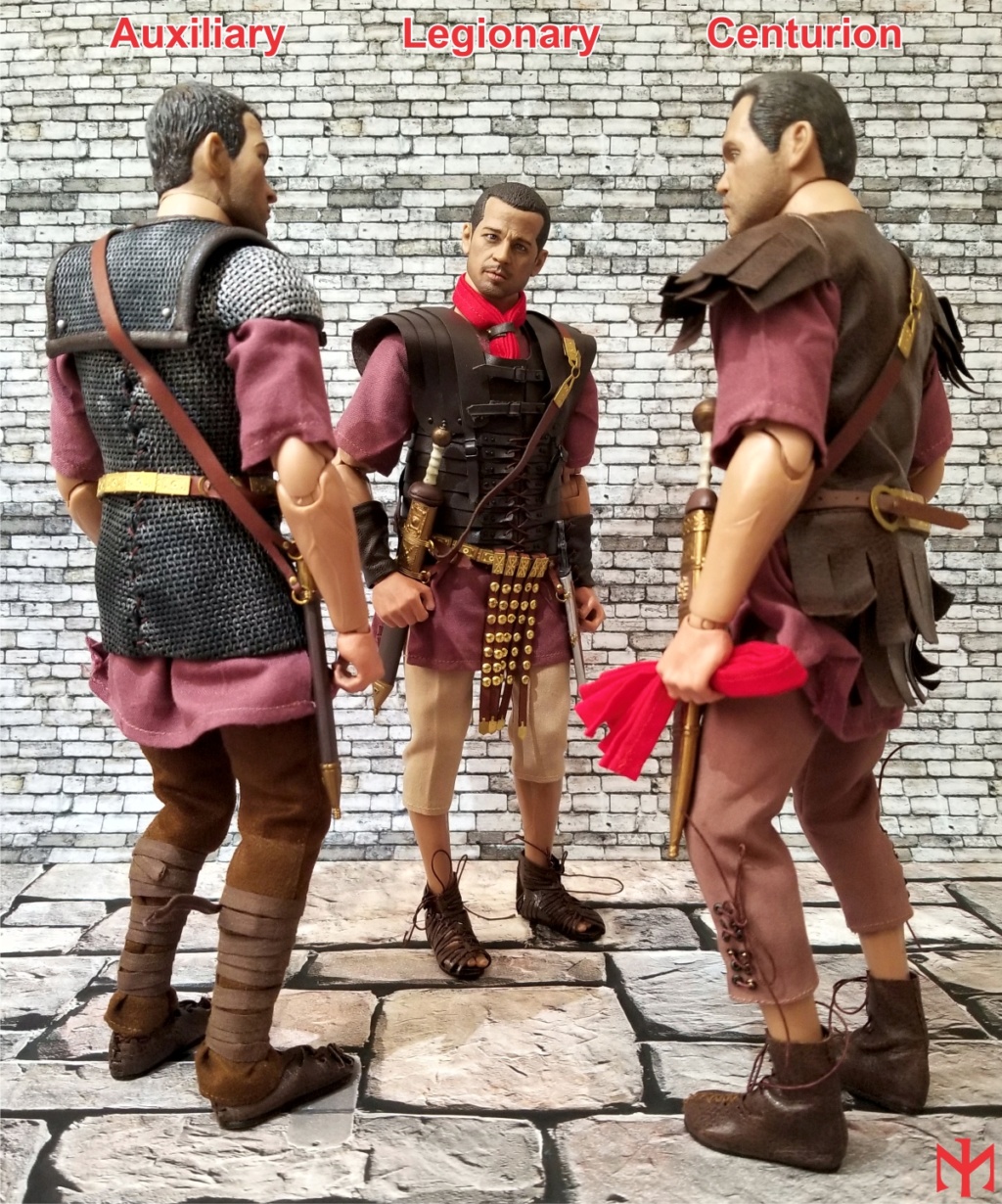
Things to watch out for
A lot. With all the layers of clothing and armor (including helmets), accessories (weapons and shileds), your figure could get relatively top heavy, easily lose balance, and topple over. In fact, given the loose ankle and knee joints, it might fall over even sooner. The many and intricate tiny details are not likely to hold up well if the figure fell from any considerable height, and many of the items are fragile or flimsily attached. I lost count of how many times I had to use super glue on something that came loose, including the plaques on the belts, and what seems like half a dozen buckles. One of the auxiliary's wrist torques snapped in two. The auxiliary's spear head and the legionary's pilum shanks do not attach very well, making them look limp and fall out easily. While they are not likely to break easily, they are likely to get lost or to stab you should you tread on them. And all this fresh out of the box, with minimal and careful handling. (The centurion's crest came badly misshapen and required some water treatment, and now looks like the sonic hedgehog...)
Overall - 3/4 stars
What should have been a set of great products has turned out to be a set of pretty good products. There is a lot here that can be appreciated, enjoyed, and possibly improved with little effort. And a lot that adds to existing or future collections. Box imagery apart, what you see in the promotional images is exactly what you get, at a fairly reasonable price for our times. But there are far too many small annoyances to make these perfect products.
For some kitbashes based largely on these sets, see HERE. Sample photo below.
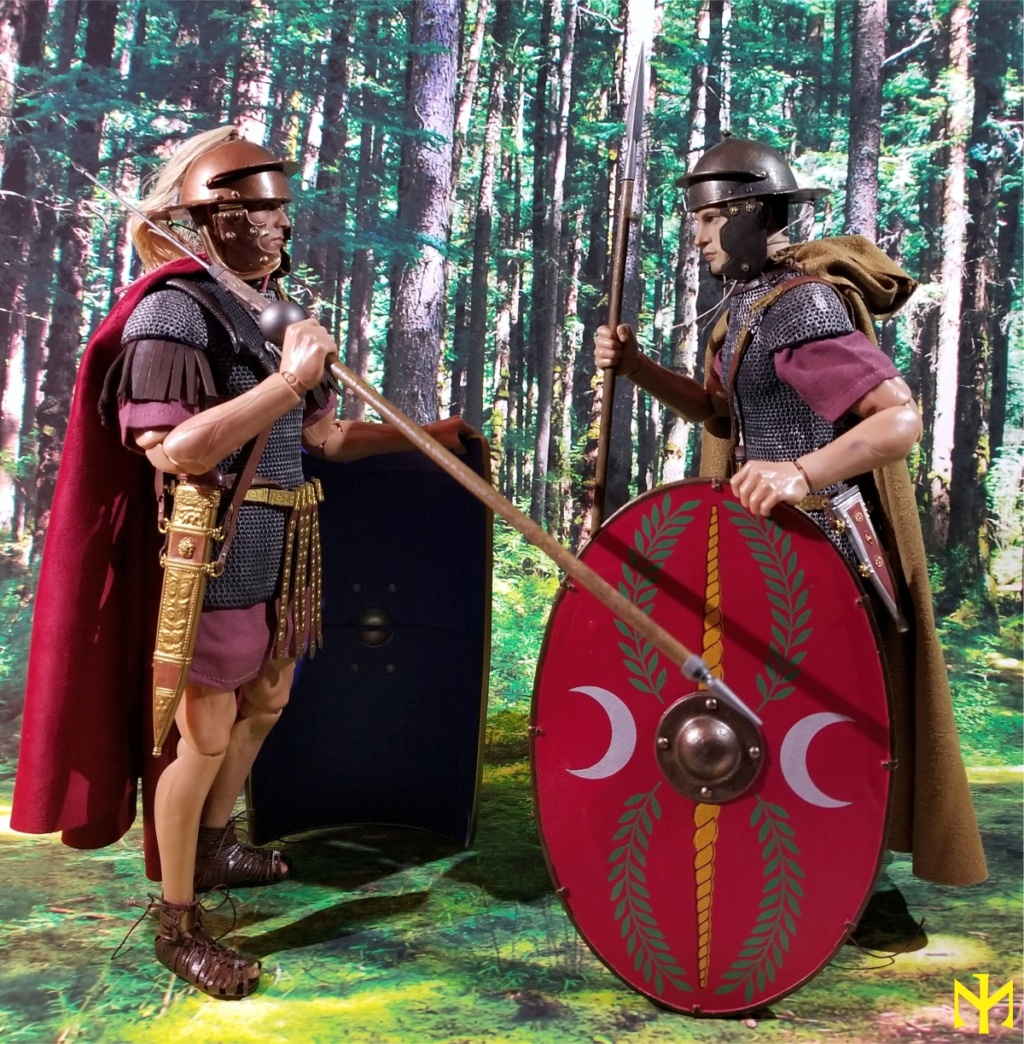
What do you think?
Where to Buy
Various options, including eBay sellers, for example these:
Big Bad Toy Store
Cotswold Collectibles
Timewalker Toys
#kausticplastik #kp #rome #romanempire #legions #military #historical #ancient #male

Introduction
The three infantry figures are a centurion, a legionary, and an auxiliary ("Auxilia Cohors") from Kaustic Plastik's The Legions of Rome - The Armies of the Roman Empire series. All three figures purport to portray the Roman military of the 1st century AD, i.e., the Julio-Claudian and Flavian periods of the Roman Empire. Kaustic Plastik figures are designed on the advice of archaeologists/military history consultants and claim a high degree of historical accuracy. That said, one should note that there is plenty of disagreement over the interpretation of pictorial, written, and archaeological evidence, and some of the design choices would be open to doubt.
The sets employ Kaustic Plastik bodies (KP04) and head sculpts and stand about 11.5 inches (29.5 cm) tall.
Packaging - 3/4 stars
All three figures come in identical boxes featuring a dark posterized version of a photo of two figures' helmeted heads overprinted with the Legions of Rome logo on the front, a general historical introduction on the back, and images of all four figures of this line (the three reviewed here, plus a cavalryman whom I will review separately) on the sides. Inside the box there is a relatively thin black foam sheet, under it a thick foam trey for the figure and some of its accessories, and under that a second, more shallow foam trey for additional accessories, including the action figure stand and the shields. The use of foam treys is commendable, and everything is reasonably safe, although some items do become loose. Inside there is also a little paper slip with a printed notice that the helmets are very delicate, should be handled carefully, and if any of the small fittings become loose it is recommended to affix them with Gorilla Superglue. So why take off one star? Because of the reusing the same box and decor for all figures in the line. This is arguably lazy, but while I do not care much about the boxes (as long as they do their job), the figures come without any instructions, and having more, larger, and varied images of each figure (on its respective box) would have been handy when trying to kit it out fully. On the other hand, if this cost-saving measure accounts for the relatively inexpensive price, that aspect is appreciated.

Sculpting - 3/4 stars
By sculpting I mean primarily the head sculpts, although there are plenty of sculpted details on the plastic and metal accessories that make up each figure's armor and weaponry. In the latter case, the detail is fairly accurate and quite exquisite, even if not always super sharp. In the former case, two out of the three heads are very well sculpted, while that of the auxiliary has the same high production quality, but suffers from fairly caricature-like features that detract from the intended realism. Moreover, all three head sculpts are reused from Kaustic Plastik products we have seen before: the centurion's head came with the KP03B body, the legionary's head came with the KP04B body, and the auxiliary's head came with "Valerius - Roman Legionary" ("Ancient Rome - The Roman Army - Legio XIV Gemina, Invasion of Britain circa 49 AD"). While I appreciate any savings in cost, this reuse is hardly something that impresses in the new products.

Paint - 3.5/4 stars
Generally speaking, the paint job is very good -- and even in instances where it is not particularly clean, that is perhaps on purpose, certainly contributing to the look of worn, used equipment. The most elaborate and detailed paintwork is on the head sculpts (see photo above), and that tends to be excellent, with plenty of good detail and nuance. There is also some fairly intricate paintwork involved with the various tiny sculpted details on the armor (centurion), sheaths (all figures), and shields. The "chain" mail on the auxiliary (and also on the cavalryman I would be reviewing separately) is made of molded rubber and has a very convincing paint treatment ranging from silverish to dark grey.

Articulation and Poseability - 2.5/4 stars
Why add "poseability" to the description of this category? Because it is different from the articulation, as I will show. In terms range of movement (articulation), the Kaustic Plastik bodies are very good, featuring almost everything you might want, including double-jointed knees and elbows, good ankles and wrists, ab crunch, etc. Naturally, the outfits and especially the armor (whether the molded rubber "chain" mail or the hard plastic "muscle" cuirass) get in the way a little bit, but that is normal. In fact, I am surprised at how little they hinder the range of movement (though I have not necessarily shown its full limits in the photos). A bonus for the kitbasher are the removable arms, which are pretty much a must if you want to remove or swap some of the outfit. However, when it comes to the ability to pose the figures, the products are plagued with difficulty. The knee and ankle joins in particular are fairly loose, and when you add to this the weight of plastic and metal weapons and armor, it becomes exceedingly difficult to achieve a balanced unassisted standing pose in any animated stance. For example, see the legionary in the photo below? He had to lean on his shield to stand in this stance, which wasn't even what I was going for in the first place. So while the articulation is good in itself, the poseability is fairly poor.

Accessories - 3/4 stars
Since we are looking at three figures at once, let's start with what they have in common: the "deluxe" figure stand, the dagger (pugio) with its sheath hanging from the military belt (cingulum militare), the sword (gladius) with its sheath hanging from a baldric, the two sets of hands (spear/sword/knife grip and trigger grip -- the latter is somewhat surprising given the nature of the product). The weapons' blades are made of metal, while the hands are made of fairly soft plastic -- something this reviewer appreciates, given the typical challenges of making a figure hold a shield or swapping weapons. Each figures comes with its own distinctive plastic shield -- the centurion and legionary have a similar and familiar design (scutum), but with slight variations, while the auxiliary sports an oval shield with painted decoration. At least generally speaking, this appears accurate for the period, although the universal reliance on red is a bit of a modernist cliche. The centurion sports an extra (and extra wide) belt to go over his armor. The belts are made of thin leather-like material with affixed and embossed metal plaques -- this works better in theory than in practice (see below). The auxiliary has a short spear or javelin (lancea) with attachable spearhead -- which also works better in theory than in practice (see the photo in the Paint category above). He has also been given two Gallic-type wrist torques. The legionary comes with a coiled rope and with three interchangeable shanks of varying lengths and weights for his javelin (pilum).

The legionary set comes with metal Roman numerals which you can use to affix a legion number of your choice to the appropriate "field" on the shield. You will need glue and possibly a coat of paint or dull finish (I have not yet applied the latter). This set also comes with additional pendants that could be attached to the ends of the danglers, but that seemed too fragile and too much trouble for me to affix.

I am subtracting a star from this category because of the overly fragile or flimsy attachment of many of the elements, a source of much annoyance: see below.
Outfit - 3.5/4 stars
The centurion wears a red tunic, a leather-like jerkin (subarmalis) with two rows of pendant straps (pteryges) at both the bottom and the shoulders, and a muscled cuirass (whether it is intended to represent one made of leather or bronze is not specified -- although the color appears far too dark for ancient bronze). He also has red-brown pants (feminalia) reaching down to the upper calf and his lower legs can be protected by greaves (ocrae). On his feet he wears closed boots (calcei) with silverish hobnails. His lower neck is protected from the armor by a red military scarf (focale), and a heavy velvet-like red cloak hangs rather loosely from specially designated holes in the muscle cuirass. He has a metal Gallic Type E helmet with an attachable transverse crest. Apart from perpetuating the simplistic notion that the Romans employed red consistently or uniformly for such items as the military tunics, the choice of pants for a figure representing typical 1st century AD military personnel is somewhat surprising -- they are generally agreed to have come into common use late in that century, closer to the Year 100.

The legionary wears a red tunic, leather-like armor, knee-length light brown pants (feminalia), military boots (caligae) with silverish hobnails, leather-like wrist bands protecting the lower arms. His neck is protected by the red military scarf (focale) and he has a red hooded cloak to wear. His metal helmet is of the Coolus Type G, with a beige plume. The leather armor and wrist bands are of debatable historical accuracy. Generally, discrete wrist guards are not believed to have been part of typical legionary armament, and are common only among archers. The evidence for leather armor as anything more than an underarmor jerkin is particularly contentious. The promotional materials indicate that the leather armor that comes with this set is based on a drawing in Robert von Spalart book on historical costume (from 1798). Although not everything dated is necessarily wrong, that does not carry much weight with military historians today, and most interpretations based on pictorial or sculptural evidence are open to debate. Allegedly fragments of Roman leather armor have been found in Egypt, and Raffaele d'Amato's Roman Army Units in the Eastern Provinces 31 BC-AD 195 does include an illustration of banded leather armor worn by a city guard (not a legionary), citing pictorial evidence from an Egyptian linen shroud and from Anatolian monuments. Using "chain" mail would have been a considerably less controversial and more convincing choice; the use of pants is also possibly questionable, as they became more common late in the 1st century (as noted above).

The auxiliary wears a red tunic, molded rubber "chain" mail with short sleeves and additional leather-lined "chain" mail shoulder guards (giving the armor the overall impression of a Greek linothorax), and . He had brown long pants (braccae), with his calves additionally protected by leg wrappings. He has been given Gallic closed sandals without hobnails, although it is likely that many or most infantry auxiliaries would have worn typical military boots (caligae). I suppose there is something to be said for variety. The pants (though more typically of the shorter type, feminalia) are less questionable here, as they appear to have come into common use among auxiliaries earlier than among legionaries, by the mid-1st century. This would have been especially true in the northern provinces along the upper Danube and the Rhine, and in Britain. The auxiliary sports a metal Coolus Type C helmet without a plume or crest.

Fun Factor - 3/4 stars
With four different contemporary figures produced at the same time, not to mention any of Kaustic Plastik's earlier Roman releases (gladiators and military alike), the fun factor for these products should skyrocket. Historically debatable choices aside, the attention to detail is commendable, as is the range of options we get at once and over time. What hurts these products in this category is the common issue of limited poseability (due to overly loose joints) and the flimsiness of a number of articles that break repeatedly with minimal handling (more on that below) -- which makes posing these figures a frustrating rather than fun experience. On the other hand, if you just want to stick them on the provided figure stands and forget about them on a shelf, that frustration largely disappears.

Value - 3/4 stars
Retailing at about $140-160 (USD), these are not particularly expensive for high-end action figures these days (something relative, of course). Given the research, care, and large number of fine accessories that come with these sets, I would have given this category a full 4 stars had it not been for the frustrating issues mentioned above.

Things to watch out for
A lot. With all the layers of clothing and armor (including helmets), accessories (weapons and shileds), your figure could get relatively top heavy, easily lose balance, and topple over. In fact, given the loose ankle and knee joints, it might fall over even sooner. The many and intricate tiny details are not likely to hold up well if the figure fell from any considerable height, and many of the items are fragile or flimsily attached. I lost count of how many times I had to use super glue on something that came loose, including the plaques on the belts, and what seems like half a dozen buckles. One of the auxiliary's wrist torques snapped in two. The auxiliary's spear head and the legionary's pilum shanks do not attach very well, making them look limp and fall out easily. While they are not likely to break easily, they are likely to get lost or to stab you should you tread on them. And all this fresh out of the box, with minimal and careful handling. (The centurion's crest came badly misshapen and required some water treatment, and now looks like the sonic hedgehog...)
Overall - 3/4 stars
What should have been a set of great products has turned out to be a set of pretty good products. There is a lot here that can be appreciated, enjoyed, and possibly improved with little effort. And a lot that adds to existing or future collections. Box imagery apart, what you see in the promotional images is exactly what you get, at a fairly reasonable price for our times. But there are far too many small annoyances to make these perfect products.
For some kitbashes based largely on these sets, see HERE. Sample photo below.

What do you think?
Where to Buy
Various options, including eBay sellers, for example these:
Big Bad Toy Store
Cotswold Collectibles
Timewalker Toys
#kausticplastik #kp #rome #romanempire #legions #military #historical #ancient #male




